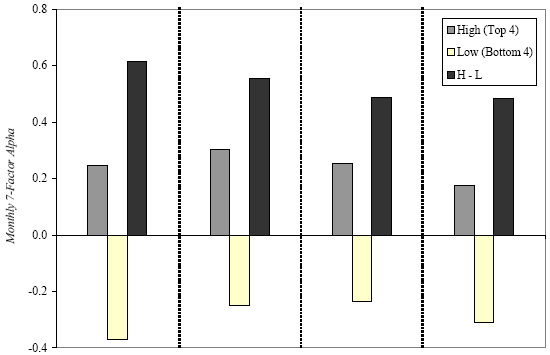Does bias on the part of U.S. investors in favor of companies headquartered within their home states create opportunities for geographical abnormal returns? In the February 2008 draft of their paper entitled “Long Georgia, Short Colorado? The Geography of Return Predictability”, George Korniotis and Alok Kumar investigate whether the behavior of local investors in response to local economic conditions produces predictable patterns in the returns of local stocks. They define local as individual U.S. states. They define local economic conditions as the combination of: (1) growth rate of state labor income; (2) state unemployment rate relative to a moving average; and, (3) state-level housing collateral ratio (as a measure of borrowing constraints). Using quarterly state-level economic data, company headquarters locations and quarterly stock return data for 1980-2004 (covering a total of 39 states as limited by sample size), they conclude that:
- A decrease in local demand for local stocks, as inferred from a decrease in state income growth and increases in relative state unemployment and and borrowing constraints, indicates higher state portfolio returns in the next quarter.
- The effect of local demand is predictable both in the short-run (one quarter) and the long-run (up to 24 quarters).
- Predictability is stronger for less visible firms (more likely to have disproportionate local investment) and for regions where investors exhibit stronger local bias and hold more concentrated portfolios.
- A hedged trading strategy that is long (short) the stocks of states with the highest (lowest) predicted returns, equally-weighted and rebalanced quarterly, generates an economically significant annualized risk-adjusted return of over 8%.
The following chart, taken from the paper, shows monthly seven-factor alphas for four out-of-sample hedged trading strategies during 1995-2004. The seven risk-adjustment factors include the risk-free rate, size, book-to-market value, momentum and three industry factors designed to capture industry momentum. Each trading strategy is long (short) firms headquartered in the four states predicted to have the highest (lowest) returns, with state portfolios equally weighted. The chart shows the alphas of the long side of each strategy (“High”), the short side of each strategy (“Low”) and the net hedged result (“H – L”). The four strategies differ in the parameters used to predict which states will outperform and underperform as follows, from left to right: (1) excess state returns over the risk-free rate; (2) excess state returns over the broad stock market; (3) industry-adjusted returns; and, (4) characteristic-adjusted returns.

In summary, investors may be able to exploit local bias-induced undervaluation (overvaluation) of stocks headquartered in U.S. states with depressed (exuberant) economies.